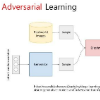In this paper, we present a novel adversarial lossy video compression model. At extremely low bit-rates, standard video coding schemes suffer from unpleasant reconstruction artifacts such as blocking, ringing etc. Existing learned neural approaches to video compression have achieved reasonable success on reducing the bit-rate for efficient transmission and reduce the impact of artifacts to an extent. However, they still tend to produce blurred results under extreme compression. In this paper, we present a deep adversarial learned video compression model that minimizes an auxiliary adversarial distortion objective. We find this adversarial objective to correlate better with human perceptual quality judgement relative to traditional quality metrics such as MS-SSIM and PSNR. Our experiments using a state-of-the-art learned video compression system demonstrate a reduction of perceptual artifacts and reconstruction of detail lost especially under extremely high compression.
翻译:在本文中,我们展示了一个新的对抗性损耗视频压缩模型。在极低的位速率下,标准视频编码方案受到阻碍、铃声等令人不愉快的重建文物的影响。现有的视频压缩神经神经学方法在降低高效传输的比特率和在一定程度上减少文物影响方面取得了合理的成功。然而,它们仍然倾向于在极端压缩下产生模糊的结果。在本文中,我们展示了深度对抗性视频压缩模型,最大限度地减少辅助性对抗扭曲目标。我们发现,这一对抗性目标与人类感知质量判断相比,与MS-SSIM和PSNR等传统质量衡量标准更加相关。我们使用最先进的视频压缩系统进行的实验表明,人们的感知性文物有所减少,特别在极高的压缩下损失的细节也得到了重建。



